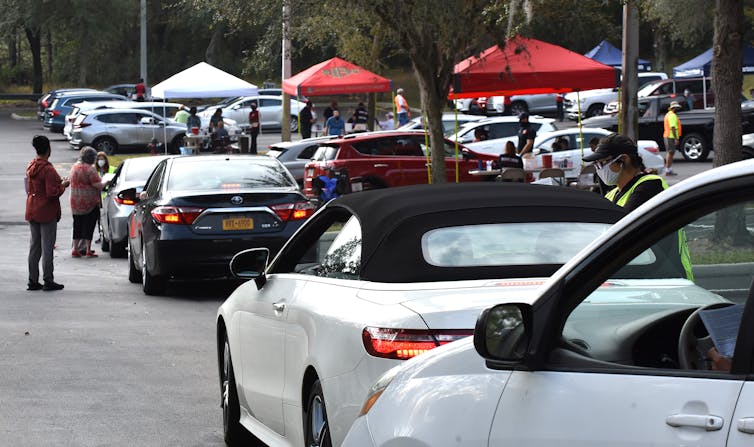Giving Compass' Take:
- Timothy Callaghan and Matt Motta explain the challenges associated with achieving widespread COVID-19 vaccination as some people resist.
- What role can you play in building trust around COVID vaccines?
- Read about barriers to trust in the COVID-19 vaccination effort.
What is Giving Compass?
We connect donors to learning resources and ways to support community-led solutions. Learn more about us.
Today, more Americans hope to receive a COVID-19 vaccine than current vaccine supply will allow. Consequently, although President Joe Biden’s initial promise to dole out 100 million vaccine doses in 100 days would require a ramp-up in vaccine allocation, some consider the promise to be insufficient to meet current levels of demand and put the pandemic’s spread into decline.
The current mismatch between vaccine demand and supply, however, may be short-lived. Despite concerns about lagging vaccine allocation for front-line health care workers and other vulnerable groups, health experts are optimistic that public demand for a COVID-19 vaccine will remain high in coming months as more vaccine doses become available.
While it is clear that many political leaders expect public demand for a coronavirus vaccine to be strong, whether or not expectations can live up to reality is an open question. In fact, there is some evidence to suggest instead that large segments of both the public and health care workers do not intend to get vaccinated against COVID-19.

Alex Wong via Getty Images
Figuring out whether or not some people are less likely to get vaccinated – and their reasons for not getting vaccinated – can help political leaders and health professionals better anticipate vaccine demand. If some social, political and other demographic groups are more (or less) likely to intend to get vaccinated than others, demand for a vaccine may be higher (or lower) in vaccine distribution networks that primarily service vaccine-hesitant groups.
Additionally, understanding why some individuals are more likely to refuse vaccination than others can help inform health communication efforts to increase vaccine uptake. For example, if some Americans intend to refuse to get vaccinated due to concerns that the vaccine is not safe, health communicators can target these groups with easy-to-understand information about how scientists determined that the vaccine is safe.
In a recent peer-reviewed study, we provide important insight into what public demand for a coronavirus vaccine could actually look like, once most Americans have the opportunity to get vaccinated. Just as important, we detail reasons certain Americans do not intend to get vaccinated.

Paul Hennessy/NurPhoto via Getty Images
Some Americans more likely to get vaccinated
We studied Americans’ COVID-19 vaccination intentions in a large, demographically representative online survey of 5,009 U.S. adults, conducted in June 2020. We measured vaccination intentions by asking respondents whether or not they would pursue getting vaccinated for the coronavirus if a COVID-19 vaccine became available.
Our study found that almost a third (31.1%) of respondents did not intend to pursue vaccination. This is concerning, given that recent epidemiological estimates suggest that up to 70% of Americans must become immune to COVID-19 in order to put the pandemic’s spread into decline.
We also found strong differences in vaccination intention between key demographic groups. Notably, we found that 35.7% of women (vs. 26.3% of men), 42.9% of Black people (vs. 28.6% of white people), and 37.8% of conservatives (vs. 33.4% of independents and 24.1% of liberals) intended to forgo vaccination.
Why will some people refuse a COVID-19 vaccine?
Our study provides new insights into the reasons that some Americans do not intend to get vaccinated against COVID-19. We found that concerns about the safety and effectiveness of the vaccine were the most consistent reasons for forgoing vaccination. We also found that portions of the American public did not intend to pursue vaccination because they lack health insurance, lack the financial resources they believe they need to be vaccinated or because they have already had COVID-19.
Our study also found considerable evidence that the reasons for not vaccinating were not the same for everyone. For example, women were more likely than men to say they would forgo vaccination due to concerns about safety and effectiveness. Additionally, we found that Black people were more likely to skip vaccination than white people due to perceived safety and effectiveness issues as well as concerns related to the cost of vaccinating and a lack of health insurance.
What this all means for vaccine uptake
Together, our findings point to two key takeaways as the U.S. pushes to rapidly vaccinate its population against COVID-19. First, political leaders and public health experts need to recognize that what appears to be considerable public demand for the COVID-19 vaccine right now may be more modest in the coming months, as more Americans have the opportunity to get vaccinated. In its place, experts will be faced with the new challenge of convincing hesitant groups to get vaccinated in order to reach herd immunity and end the pandemic.
Second, our results demonstrate that in these efforts to vaccinate the hesitant, a one-size-fits-all approach to health communications will be insufficient. While health communications aimed at emphasizing the safety and effectiveness of the vaccine will be important, for some groups, it will be just as important to emphasize that Americans can be vaccinated against COVID-19 for free, regardless of insurance status. Developing these communications and identifying appropriate messengers to deliver this information will be vital to stopping the pandemic.
Timothy Callaghan, Assistant Professor, Texas A&M University School of Public Health, Texas A&M University and Matt Motta, Assistant Professor of Political Science, Oklahoma State University
This article is republished from The Conversation under a Creative Commons license. Read the original article. The Conversation is a nonprofit news source dedicated to spreading ideas and expertise from academia into the public discourse.